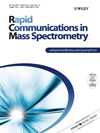
RAPID COMMUNICATIONS IN MASS SPECTROMETRY
Scope & Guideline
Advancing the frontiers of mass spectrometry research.
Introduction
Aims and Scopes
- Methodological Advancements:
The journal emphasizes the development of new mass spectrometric techniques and enhancements to existing methods, such as ion mobility spectrometry, tandem mass spectrometry, and high-resolution mass spectrometry. - Application in Various Fields:
Research published often highlights applications of mass spectrometry across diverse domains including environmental science, pharmacology, food safety, and clinical diagnostics. - Isotopic Analysis:
A significant focus is placed on stable isotope analysis, exploring its applications in environmental studies, dietary investigations, and forensic science. - Metabolomics and Proteomics:
The journal frequently features studies on metabolomics and proteomics, emphasizing the role of mass spectrometry in biomarker discovery and analysis of complex biological samples. - Doping Control and Pharmaceutical Analysis:
Research related to doping control in sports and the analysis of pharmaceuticals is prevalent, demonstrating the journal's commitment to addressing societal issues through mass spectrometry. - Machine Learning and Data Analysis:
The integration of machine learning techniques and advanced data analysis methods in mass spectrometry research is increasingly highlighted, indicating a trend towards computational approaches.
Trending and Emerging
- Integration of Machine Learning:
A significant increase in studies using machine learning for data analysis and compound identification in mass spectrometry indicates a trend towards computationally-driven research. - Advanced Isotope Ratio Techniques:
Emerging research on advanced isotope ratio techniques, particularly in environmental and biological contexts, is gaining attention, highlighting the growing importance of isotopic studies. - High-Throughput and Automation:
There is a clear trend towards automation and high-throughput methodologies, allowing for the rapid analysis of complex samples in various fields. - Multi-Component Analysis:
Increasing interest in multi-component analysis reflects the need for comprehensive profiling in metabolomics and environmental studies, moving beyond single-analyte methodologies. - Focus on Health and Disease Biomarkers:
Research targeting health-related biomarkers, particularly in the context of metabolomics and proteomics, is on the rise, indicating a strong focus on clinical applications. - Environmental and Food Safety Applications:
The journal is increasingly publishing studies aimed at environmental monitoring and food safety, reflecting growing public interest and regulatory needs.
Declining or Waning
- Traditional Chemical Analysis:
There is a noticeable decrease in papers focused on traditional chemical analysis techniques that do not leverage the latest advancements in mass spectrometry, as newer methodologies become the norm. - Basic Ionization Techniques:
Research centered on basic ionization techniques, such as simple electrospray or matrix-assisted laser desorption, is becoming less frequent as more sophisticated ionization methods gain traction. - Historical or Low-Resolution Mass Spectrometry:
Studies that focus on historical mass spectrometric methods or low-resolution techniques are waning, as the field moves towards high-resolution and high-throughput methodologies. - Single-Analyte Studies:
The trend of single-analyte studies is declining in favor of more comprehensive approaches that analyze multiple compounds or complex mixtures simultaneously. - Environmental Monitoring with Limited Scope:
Research focusing solely on environmental monitoring without the integration of advanced mass spectrometric techniques is becoming less common.
Similar Journals

ChemistryMethods
Transforming Chemical Insights into Real-World ApplicationsChemistry Methods, published by WILEY, is an esteemed journal in the field of chemical sciences that serves as a vital platform for disseminating cutting-edge research and methodologies across various domains of chemistry. With a focus on practical approaches in areas such as fluid flow and transfer processes, spectroscopy, electrochemistry, and catalysis, this journal has achieved impressive ranks in Scopus—including a notable 15th position in both fluid flow and spectroscopy categories, which reflects its significant contribution to advancing the discipline. Although Chemistry Methods operates under a traditional access model, it remains crucial for researchers, professionals, and students who are eager to engage with high-quality original research and reviews. Since its inception in 2021, the journal's objective has been to bridge the gap between theoretical knowledge and practical application in chemistry, fostering innovation and collaboration within the global scientific community.

ANALYTICAL AND BIOANALYTICAL CHEMISTRY
Connecting Researchers with Cutting-Edge DiscoveriesANALYTICAL AND BIOANALYTICAL CHEMISTRY, published by SPRINGER HEIDELBERG, is a leading international journal that serves as a vital platform for innovative research in the fields of analytical and bioanalytical chemistry. With an impressive impact factor and ranking in the Q2 category for both Analytical Chemistry and Biochemistry, the journal highlights key advancements and methodologies that drive the discipline forward. Established in 1996 and continuing vigorously into 2024, it has gained significant recognition with Scopus rankings placing it in the 83rd and 78th percentiles within its categories, underscoring its impact and relevance. The journal's commitment to open access facilitates widespread dissemination of critical scientific knowledge, making it an essential resource for researchers, professionals, and students dedicated to exploring the complexities of chemical analysis. With its base in Heidelberg, Germany, ANALYTICAL AND BIOANALYTICAL CHEMISTRY continues to inspire and influence the global research community.
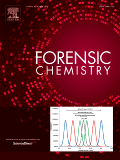
Forensic Chemistry
Exploring the intersection of science and law.Forensic Chemistry is a premier journal published by Elsevier, specializing in the interdisciplinary field of forensic science, with a strong emphasis on analytical and materials chemistry, pathology, and law. Established in 2016 and converging to a significant publication trajectory through 2024, the journal has rapidly ascended to an impressive Q1 ranking across multiple categories, demonstrating its impact and commitment to advancing forensic analysis and methodologies. With an impact factor reflecting its relevance—especially notable with a 95th percentile rank in Social Sciences and Law—Forensic Chemistry serves as an essential resource for researchers, legal authorities, and academics seeking to explore the latest developments in forensic techniques and applications. Its rigorous peer-review process and high-quality publications ensure that it remains at the forefront of scientific inquiry in forensic practices. Access to the journal is available without an open access model, further emphasizing its commitment to curated, high-impact scholarship that contributes to both theoretical foundations and practical applications in the forensic field.
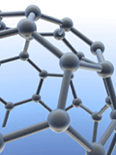
Annual Review of Analytical Chemistry
Connecting Ideas, Inspiring Innovations in ChemistryAnnual Review of Analytical Chemistry, published by Annual Reviews, is a premier journal that serves as a critical resource in the field of analytical chemistry, providing comprehensive and cutting-edge reviews that synthesize recent advancements and pivotal research findings. With an impressive impact factor and ranked Q1 in both Analytical Chemistry and Miscellaneous Medicine, it stands as a leader in disseminating knowledge that spans the intricacies of chemical analysis, enhancing the scientific discourse within the community. Available in both print (ISSN: 1936-1327) and online (E-ISSN: 1936-1335), the journal is accessible to a wide audience, fostering innovation and collaboration among researchers, professionals, and students alike. Its scope includes the converged years from 2008 to 2024, showcasing its commitment to providing relevant and timely insights that impact practice and education in analytical techniques, methodologies, and applications. The Scopus rank of #6 out of 156 in Analytical Chemistry, placing it in the 96th percentile, underscores its significance and the high regard in which it is held. As you explore the journal's offerings, you will find a wealth of knowledge that not only informs but inspires future discoveries in the realm of analytical chemistry.
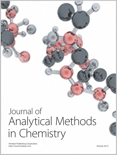
Journal of Analytical Methods in Chemistry
Fostering collaboration in the vibrant world of analytical science.The Journal of Analytical Methods in Chemistry, published by HINDAWI LTD, stands as a premier platform dedicated to the dissemination of research in the vibrant field of analytical chemistry. With an ISSN of 2090-8865 and an E-ISSN of 2090-8873, this Open Access journal has been committed to providing unrestricted access to quality research since 1978, thereby fostering greater collaboration and innovation among researchers, professionals, and students globally. The journal showcases rigorous research insights spanning diverse categories, earning impressive Scopus rankings including Q2 in Chemical Engineering and Q3 in Analytical Chemistry for 2023, positioning itself effectively among respected peers. Its interdisciplinary approach also covers significant contributions in the realms of instrumentation and computer science applications, thus addressing contemporary challenges and advancements in analytical methodologies. By bridging theoretical underpinnings with practical applications, the Journal of Analytical Methods in Chemistry aims to catalyze knowledge exchange while enhancing the global discourse in analytical science.
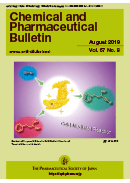
CHEMICAL & PHARMACEUTICAL BULLETIN
Bridging the gap between chemistry and drug discovery.CHEMICAL & PHARMACEUTICAL BULLETIN, published by the Pharmaceutical Society of Japan, has been a cornerstone in the fields of chemistry, drug discovery, and medicine since its inception in 1958. With an ISSN of 0009-2363, this esteemed journal offers a platform for the dissemination of innovative research and critical insights contributing to these dynamic disciplines. Housed in Tokyo, Japan, it is strategically poised to bridge the gap between chemical sciences and pharmaceutical applications. Although the journal operates under a traditional subscription model and does not currently offer open access, it maintains a solid reputation, evidenced by its Q3 category rankings in multiple relevant fields and its percentile positions in Scopus, specifically 48th in General Chemistry and 30th in Drug Discovery. Researchers, professionals, and students alike will find invaluable resources within its pages, as it diligently covers shifting paradigms and emerging methodologies critical to advancing both theoretical understanding and practical applications in the pharmaceutical realm.
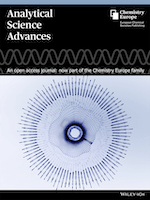
Analytical Science Advances
Transforming Analytical Chemistry Through High-Quality ResearchAnalytical Science Advances is a dynamic journal published by WILEY, dedicated to the ever-evolving field of analytical chemistry. With an ISSN of 2628-5452, this open-access platform aims to disseminate high-quality research and insightful reviews that push the boundaries of analytical methodologies and instrumentation. Since its inception in 2020, the journal has gained traction, securing a commendable Q2 ranking in 2023 within its category, highlighting its significance in the scientific community. Currently positioned at Rank #68 out of 156 in Scopus' analytical chemistry category, it boasts a 56th percentile ranking, reflecting its contributions to advancing analytical techniques. Researchers, professionals, and students will find this journal an invaluable resource for keeping abreast of the latest developments, emerging technologies, and innovative approaches in analytical science, ensuring the journal's relevancy and influence in shaping future discoveries.
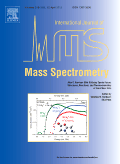
INTERNATIONAL JOURNAL OF MASS SPECTROMETRY
Illuminating the Path of Mass Spectrometry AdvancementsINTERNATIONAL JOURNAL OF MASS SPECTROMETRY, published by Elsevier, is a pivotal platform in the field of mass spectrometry, advancing the understanding and application of this essential analytical technique. With an ISSN of 1387-3806 and an E-ISSN of 1873-2798, the journal has established its significance since its inception in 1998 and continues to contribute valuable insights to the scientific community through its convergence of knowledge extending to 2024. Its scope encompasses critical areas such as condensed matter physics, instrumentation, physical and theoretical chemistry, and spectroscopy, earning recognition across various ranks and quartiles, specifically holding a Q3 classification in multiple categories for 2023. Although it does not currently operate under an open access model, the journal remains an essential resource for researchers, professionals, and students striving to deepen their expertise and stay abreast of the latest methodological developments and discoveries in mass spectrometry. With its commitment to quality and innovation, the INTERNATIONAL JOURNAL OF MASS SPECTROMETRY plays a crucial role in supporting advancements in analytical chemistry and instrumental analysis.

JPC-JOURNAL OF PLANAR CHROMATOGRAPHY-MODERN TLC
Exploring Modern TLC for Tomorrow's Discoveries.JPC-JOURNAL OF PLANAR CHROMATOGRAPHY-MODERN TLC, published by Springer Heidelberg, is a pivotal resource in the fields of Analytical Chemistry, Biochemistry, and Clinical Biochemistry. With an ISSN of 0933-4173 and an E-ISSN of 1789-0993, this journal serves as an essential platform for the dissemination of innovative research on planar chromatography techniques, specifically modern thin-layer chromatography (TLC). With its upcoming coverage extending to 2024 and a third quartile ranking (Q3) across major scientific categories in 2023, it addresses the critical advancements and applications in analytical methods. Although it does not offer open access, the journal's rigorous peer-review process ensures high-quality findings that contribute to the progression of these vital scientific disciplines. The journal is located in Heidelberg, Germany, and continues to be a beacon for researchers, professionals, and students who seek to enhance their knowledge and practice in chromatographic techniques.
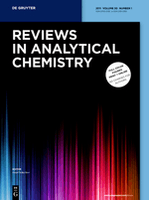
REVIEWS IN ANALYTICAL CHEMISTRY
Bridging Research and Practice in Analytical ChemistryREVIEWS IN ANALYTICAL CHEMISTRY, published by De Gruyter Poland Sp. z o.o., serves as a pivotal resource in the field of analytical chemistry, with a notable impact factor indicative of its scholarly significance. As an Open Access journal since 2020, it ensures widespread dissemination of high-quality research articles, facilitating knowledge sharing among researchers, professionals, and students alike. With its origins tracing back to 1980, the journal has adeptly adapted over the years to encompass emerging trends and innovations within analytical methodologies, maintaining its relevance and authority in the discipline. The journal is ranked in the Q2 category of analytical chemistry in 2023 and holds a commendable Scopus rank of #32 out of 156, reflecting its strong performance and the quality of the studies published. Researchers looking for cutting-edge reviews and insights will find this journal an invaluable platform for advancing their knowledge and research in analytical chemistry.